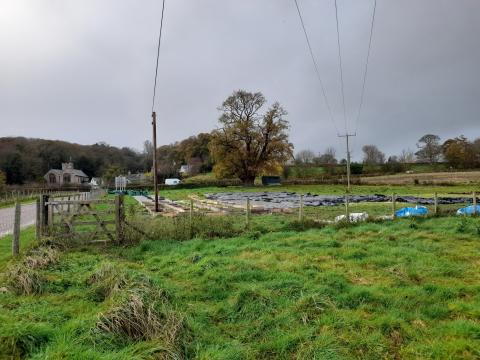Cae Derw Project Introduction
Site: Cae Derw
Address: Cae Derw, Rhyd y Cilgwyn Lodge, Rhewl, Ruthin
Technical Officer: Debbie Handley
Project Title: Diversifying into horticulture and establishing a pick your own enterprise using the no dig method
Introduction to project:
This case study will follow the process of developing a horticulture diversification project on 1.2 acres of land previously used for growing crops on a mixed farm that also has a sheep flock. The field will be divided into separate units for soft and top fruit, vegetable rows, flowerbeds and a pumpkin pick your own (PYO).
The main objective is to grow as naturally and ecologically as possible, using local resources such as compost from Ruthin and farmyard manure from the next farm. With the current situation relating to Covid-19, developing a PYO enterprise will enable people to be outdoors and connect with local food production. The intention is to sell directly to the local community through vegetable box collections, the village shop, the butcher and post office.
Establishment will use the no dig method which provides minimal disturbance of the soil life, allowing beneficial micro-organisms, worms, and fungi to thrive. As well as promoting better soil health outcomes, this also helps with weed suppression by not exposing further weed seeds for germination.
In essence, the no dig method is beneficial for speed, ease and productivity.
Wool will also be trialled as a method of suppressing weeds. The use of wool has been found to be beneficial when used in a mixture as compost or mulch. It is a sustainable, renewable product and an environmentally sustainable alternative to peat. Click here for more information.
Pumpkin pick your own enterprises are becoming increasingly popular as a way of bringing in additional income and engaging with the local community, with the benefit of having only short term extra labour input required around October. Click here for more information.
Project Objectives:
The aim is to use the no dig method to set up an ecologically sound, financially viable market garden which will include fruit, vegetables, salad crops and flowers, plus a small number of top fruit trees which will act as an agroforestry wind break and add value.
The viability of offering PYO cut flowers and pumpkins for Halloween will be evaluated.
It is also proposed to compare wool with cardboard as a base for weed suppression.
Figure 1. Bottom view of the land parcel being used
Key Performance Indicators:
To provide information and develop knowledge on:
- Labour and cost inputs required
- Profitability of different crops/enterprises
- Comparing wool and cardboard for weed suppression and composting
- Public/community engagement and buy-in
- PYO input and outcomes
Timeline and Milestones:
- December 2020 - Prepare pallet collars and raised beds for planting. Plant flower bulbs.
- January 2021 - Consultancy and on bed layouts and top fruit species. Soil testing and mentoring on planning of vegetable planting.
- February 2021 - Develop social media presence to promote interest ahead of trading
- March 2021 - Sowing seeds and preparing the ground for planting
- April 2021 - Start to plant out (weather dependant)
- May 2021 - Growing.
- June 2021 - Growing and some harvesting of early crops. PYO flowers start.
- July-September 2021 - Growing and harvesting. PYO flowers and vegetable boxes.
- October 2021 - Pumpkin PYO.
- December 2021 - Review of growing year and methods used.

